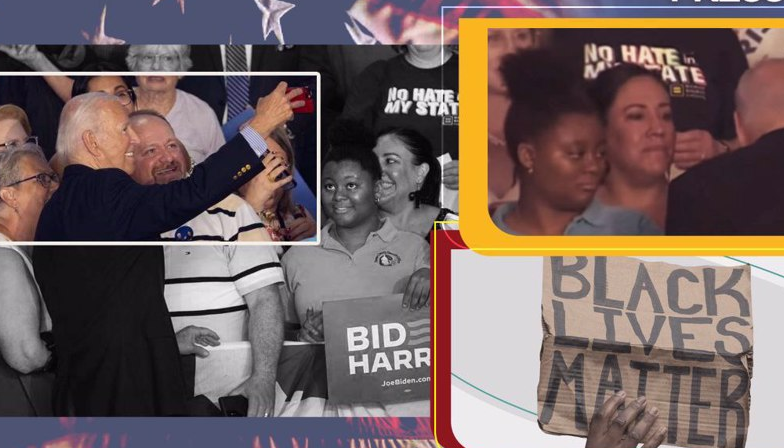
s
Washington, July 15 (RHC)– A viral video of U.S. President Joe Biden ignoring a young Black woman during a public event in Madison, Wisconsin, has rekindled the long-running debate over deeply entrenched racism in American politics.
In the video, Biden, who is running for the U.S. presidency again, is seen bypassing a Black woman who holds a Biden-Harris placard in her hand and appears seemingly excited to greet the president.
The Democratic president, whose health issues have come under scrutiny following the disastrous first televised presidential debate with Donald Trump, walked past the Black girl and hugged an older lady.
The woman, visibly disappointed, just kept looking on awkwardly, prompting a wave of reactions.
The incident has again brought the focus back on the deep-rooted plague of racism afflicting American politics, including both major political parties – the Democrats and Republicans.
Biden’s overt racism has been the topic of discussion on several occasions in the past, particularly directed at people of color, including those in his own party.
On July 7, 2021, Tim Murtaugh, a visiting fellow at the Heritage Foundation, penned a commentary shedding light on racist remarks made by the U.S. president. Murtaugh highlighted Biden’s comments regarding Latinos and their concerns about receiving the COVID-19 vaccine, which implied Latinos in the United States are all undocumented immigrants subject to expulsion.
Murtaugh emphasized that Biden failed to recognize the sizeable population of over 60 million American citizens of Latino descent in the country.
Scott Walker, a columnist for The Washington Times, expressed similar sentiments in an opinion piece published on July 15, 2022. Walker criticized Biden and his family, suggesting that their remarks and actions have often exhibited racial insensitivity. He specifically referenced Jill Biden’s July 2022 speech at the conference of UnidosUS, the country’s largest Latino advocacy and civil rights organization.
“The diversity of this community — as distinct as the bodegas of the Bronx, as beautiful as the blossoms of Miami and as unique as the breakfast tacos here in San Antonio, is your strength,” she was quoted as saying.
A deeper examination of Biden’s past behavior reveals a pattern of racially charged remarks not only targeting ordinary individuals and Latinos but also extending to his former boss, Barack Obama.
Dating back to 2007, when Biden was a senator, he made a racial comment about Obama’s African-American identity, describing him as the “first mainstream African-American who is articulate and bright and clean and a nice-looking guy.”
In another instance in 2006, Biden engaged in inappropriate dialogue at a Delaware convenience store, where he remarked on the growing population of Indian-Americans from India in the state. “You cannot go to a 7-11 or a Dunkin Donuts unless you have a slight Indian accent. I’m not joking.”
Biden is, however, not the only Democratic figure to use racially insensitive language. Senator Harry Reid from Nevada made headlines during the 2008 campaign. Reid referred to Obama as a “light-skinned” Black person who lacked a “Negro dialect.”
His comments about Obama were reported in the 2010 book “Game Change” by journalists Mark Halperin and John Heilemann.
Racial insensitivity is not confined to one political party in the U.S. Both Democrats and Republicans have been criticized for their use of derogatory or insensitive language toward minority groups. On March 29, 2013, Congressman Don Young faced criticism for using the term “wetbacks” to refer to Latino farm workers, a term widely regarded as derogatory and offensive.
Another notable incident occurred in 2006 when Republican Senator George Allen used the term “macaca” to address an Indian-American campaign volunteer during a campaign stop.
In 2012, Republican Mayor Joseph Maturo found himself in hot water when he faced allegations of racial profiling within his police department towards Latinos. When asked during a local TV interview what he would do for the Latino community amid allegations of police harassment, Maturo replied: “I might have tacos when I go home. I’m not quite sure yet.”
Former President Donald Trump, a key figure in the Republican camp, is famously infamous for his use of racist language targeting various groups, including religious and ethnic minorities and women.
John R. O’Donnell’s 1991 book said Trump made disparaging remarks about African Americans, stating: “I have Black guys counting my money… I hate it… laziness is a trait in Blacks. It really is, I believe that.”
On the campaign trail, before he assumed the office of presidency in 2017 and later in 2021, Trump made openly racist and derogatory remarks, calling Mexican immigrants criminals and urging a ban on all Muslims entering the United States.
In 2016, he addressed Black Americans with these words: “You’re living in poverty, your schools are no good, you have no jobs, 58 percent of your youth is unemployed. What the hell do you have to lose?”
A year later, he said all those entering the U.S. from Haiti “have AIDS” and added that those coming to the U.S. from Nigeria would never “go back to their huts.”
More famously, he referred to Haiti and African countries as “shithole countries” at an immigration event in January 2018 during his presidency, clearly and unapologetically preferring whites to Blacks.
The issue of racism has permeated the United States beyond politics, extending to Hollywood as well, as highlighted by Troy Williams, a member of the Community Advisory Board. On November 20, 2020, Williams raised alarm about pervasive racism in Hollywood, noting how people of color, including Native Americans, Asians and Blacks, are targets of racial discrimination.
Racism has defined Hollywood since its inception in the early 1900s. All people of color, particularly Native Americans, Asians and Blacks, were repeated targets of racism.
As with Asians and Native Americans, Black characters often weren’t played by Black people in the early days of Hollywood. They hardly appeared at all, except as caricatures played by white actors in blackface, red-face or yellow-face.
Williams drew attention to the lack of representation and recognition for Black actors in the American film industry, citing the stark disparity in Academy Awards since 1928.


